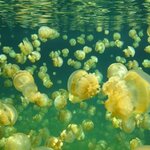Oceanography

With Tropical Storm Ida currently dumping rain and high winds in the southeast we wanted to talk about coastal hazards. Coastal hazards along America's shorelines threaten a significant percentage of the U.S. population. Here is a quick beach quiz to find out how much
you know about your risks.
1: What is a coastal hazard? a) Windb) Waves c) Flooding
d) All of the abovee) None of the above
2: How many miles of shoreline does the United States have exposed to coastal
hazards?a) …

This post is not even remotely about a cephalopod, but because I mentioned polyps yesterday I feel justified in discussing a cnidarian. Besides, these headlines really got me steamed, and what better place to vent than a blog?
Enormous Jellyfish Sink Japanese Fishing Boat (Fox News)Japanese fishing trawler sunk by giant jellyfish (Telegraph)
In the text of the articles we read that Nomura's jellyfish is "an authentic horror of the deep that's been assaulting Japan" and has now "brought down" a 10-ton fishing trawler.
Are you kidding me? How can a jellyfish, no matter how giant, sink a boat?…

I need to call my broker and get in on some Arm&Hammer stock, because, according to Steve Levitt, we're going to need a lot of base:
Of course, ocean acidification is an import issue. Now, there are ways to deal with ocean acidification, right, it's actually, that's actually, we know exactly how to un-acidifiy the oceans, is to pour a bunch of base into it, so, so if that turns out to be an incredibly big problem, then we can deal with that.
What's going on here is that Levitt is trying to defend is claim that we don't have to worry about CO2 levels as we tackle global warming. One of the…
Beauty can't hide! Flower gardens exist in our vast oceans. Fishermen have long noted colored fish and coral reefs in the Gulf of Mexico. The flower gardens banks consist of coral-capped banks or sandstone banks with fire coral and sponge-laden pinnacles and flats. Thirteen red dots in the following map locate such banks so close to the northwestern Gulf shores. These coral reefs are the northernmost in the continental United States.
Also shown in the map are the lines indicating the location of oil and gas pipelines in green and the shipping fairways…
Scientists hope weather data from 18th century ships' logbooks will shed light on how the climate has changed in the past 200 years, according to this BBC report.
Researchers in the UK are digitizing (or, in their world, digitising) almost 300 Royal Navy captains' logs from voyages dating back to the 18th century, including Darwin (HMS Beagle), Captain Cook (HMS Discovery) and Captain Bligh (The Bounty). The books will be publicly available on the UK's National Archives site next year, but scientists are using some of the early data to build up a picture of weather patterns in the world at…

The Eastern Seaboard had higher than normal sea levels in June and July and a new NOAA technical report blames persistent winds and a weakened current in the Mid-Atlantic .
After observing water levels six inches to two feet higher than originally predicted, NOAA scientists began analyzing data from select tide stations and buoys from Maine to Florida and found that a weakening of the Florida Current Transport—an oceanic current that feeds into the Gulf Stream—in addition to steady and persistent Northeast winds, contributed to this anomaly.
The highest atypical sea levels occurred…

Scientists have been thinking increasingly about whether or not animals in the ocean might play a role in larger-scale ocean mixing, says John Dabiri, a Caltech bioengineer. Ocean mixing is the process by which various layers of water interact with one another to distribute heat, nutrients and gasses throughout the oceans.
"The perspective we usually take is how the ocean--by its currents, temperature, and chemistry--is affecting animals," says Dabiri, who, along with graduate student Kakani Katija, discovered the new mechanism. "But there have been increasing suggestions that the inverse is…

When glaciers advanced over much of the planet's surface during the last ice age, what kept Earth from freezing over entirely? Climate scientists are unsure because popular numerical models indicated that over the past 24 million years geological conditions should have caused carbon dioxide levels in the atmosphere to plummet, possibly leading to runaway "icehouse" conditions - yes, we needed CO2-related global warming, they said - but researchers writing in Nature claims plants are a missing piece of the puzzle.
The research team, led by Mark Pagani of Yale University, found that…

The tuna sandwich has been the staple of the snatched office lunch for a generation.
But our favourite fish filling could soon vanish from the high street.
Sandwich chain Pret a Manger yesterday announced it is scrapping its tuna and cucumber sandwiches - and taking premium bluefin tuna out of its sushi boxes - amid concerns about overfishing.
Other stores and sandwich chains are under pressure to follow suit.
Pret founder Julian Metcalfe made the decision after being horrified by a hard-hitting new documentary on the state of the world's oceans.
The End of the Line, which premieres…

Very cool news- a ROV recently dove to the Challenger Deep in the Mariana Trench. Here's the basics over at Discover.
I can't wait until they release more images. It's very exciting that technology is starting to catch up with our desire to know more about the oceans, and pictures of crazy ocean critters are good attention-getters, particularly for my students. (Also, the kid inside me can't help but hope that the bottom of the Marianas Trench is kinda like this.)
If you know anyone who needs inspiration to be interested in our oceans, tell them to check out Sylvia Earle's…